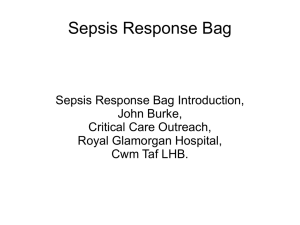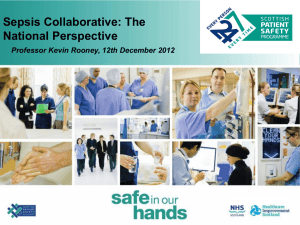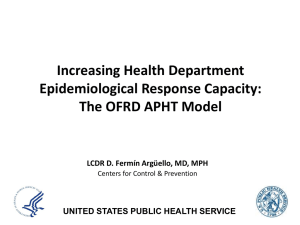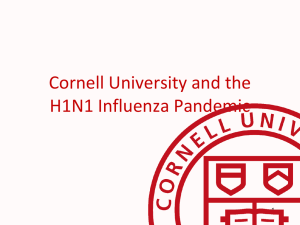Lessons on Influenza and other infections
advertisement
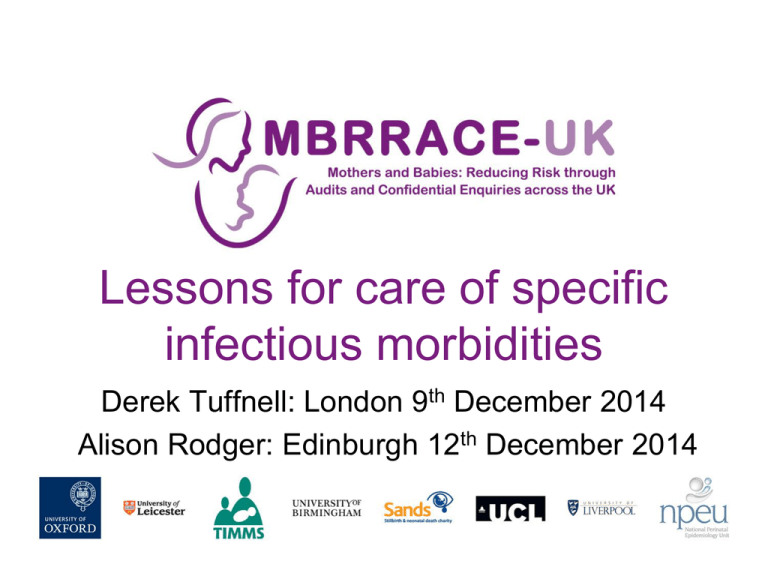
Lessons for care of specific infectious morbidities Derek Tuffnell: London 9th December 2014 Alison Rodger: Edinburgh 12th December 2014 Summary of Deaths from Sepsis • 83 women died from sepsis between 2009 and 2012 – 20 deaths from genital tract sepsis – 63 deaths from other infections • 36 due to influenza • 27 due to other infections • 12 of the deaths were late deaths (>42 days) Background: Risk Factors for Maternal Sepsis Incidence of severe sepsis Septic Shock = 4.7/10,000 (ci 4.2-5.2) = 0.91/10,000 (ci 0.71-1.15) Risk Factors • • • • • • • Ethnic minority groups (Black & other ethnic minority groups) Low socio-economic status Primiparous Diabetes Hypertension Mode of delivery Febrile illness and antibiotic treatment in the 2 weeks pre-admission Acosta CD, Kurinczuk JJ, Lucas DN, Tuffnell DJ, et al. (2014) Severe Maternal Sepsis in the UK, 2011–2012: A National Case-Control Study. PLoS Med 11(7): e1001672. doi:10.1371/journal.pmed.1001672 Absolute risk (95% CI) of all sepsis and severe sepsis/septic shock as a function of the number of a priori risk factors. Acosta CD, Knight M, Lee HC, Kurinczuk JJ, et al. (2013) The Continuum of Maternal Sepsis Severity: Incidence and Risk Factors in a Population-Based Cohort Study. PLoS ONE 8(7): e67175. doi:10.1371/journal.pone.0067175 Mortality Rates from Genital Tract Sepsis: 1985 - 2011 1.80 1.60 Rate per 100,000 maternities 1.40 1.20 1.00 0.80 0.60 0.40 0.20 0.00 1985-87 1988-90 1991-93 1994-96 1997-99 Triennium 2000-02 2003-05 2006-08 Significant decrease in mortality rate from genital tract sepsis from 1.13 maternal deaths per 100,000 maternities in 2006-8 to 0.50 per 100,000 in 2010-12 2009-11 Causative organism according to septic shock diagnosis 50 45 Proportion of women (%) 40 35 30 25 20 15 10 5 0 E.coli Group A strep Group B strep Other strep Septic shock Staph Mixed Other Unknown No shock Acosta CD, Kurinczuk JJ, Lucas DN, Tuffnell DJ, et al. (2014) Severe Maternal Sepsis in the UK, 2011–2012: A National Case-Control Study. PLoS Med 11(7): e1001672. doi:10.1371/journal.pmed.1001672 No Lab confirmed infection Group A Streptococcus (GAS) • GAS is most common cause of post partum maternal death worldwide • Postpartum women have 20x increased incidence of GAS disease compared to non-pregnant women • Puerperal infections present rapidly and can be nonspecific, delaying treatment. • Primary symptoms include myalgia, fever, confusion, euphoria, dizziness, and abdominal pain. • Once GAS is diagnosed, infection is often advanced. • Associated with STSS Potential routes of GAS infection during pregnancy and postpartum Am J Reprod Immunol, 2012 February ; 67(2): 91–100 Genital Tract Sepsis • A total of 20 women died from genital tract sepsis • Group A Streptococcus (n=12) associated with genital tract infections in early pregnancy (n=4) and peripartum (6 SVD, 2 LSCS) • Three women with GAS had no clear genital focus • Coliforms were associated with second trimester ascending infections (n=6) Genital Tract Sepsis: Delays in Management • Delay in identification of the source of infection • When recognised as genital tract – not fully investigated or monitored • Over-reliance on antibiotics to control the infection at source • Poor recourse to imaging & repeated imaging – MRI / CT scan • Reluctance to take surgical measures - appropriate drainage of collections or surgical excision of infected tissue “A woman presented in labour and was noted to have genital tract sepsis. She was delivered by caesarean section. The operation was complicated by a lateral tear and atony with an estimated blood loss of 1500mls. She was given intravenous antibiotics for 48 hours after delivery but her sepsis did not improve. There were several changes of antibiotics. On day 5 postpartum a CT scan was performed and found what was thought to be an area of sepsis in the wound communicating with the uterine cavity. On day 6 she worsened and a laparotomy was performed. The uterus was necrotic and the abdomen contained a great deal of pus. She had a sub-total hysterectomy and wound debridement. Despite intensive care she developed acute respiratory distress syndrome, deteriorated and died” “A woman admitted in second trimester with vomiting and preterm pre-labour rupture of the membranes. Septic - chorioamnionitis caused intrauterine death of the fetus. The sepsis resuscitation bundle was promptly applied and following blood cultures and discussion with a consultant microbiologist, antibiotics were commenced within one hour of diagnosis. Despite resuscitation she failed to improve. The team then proceeded to hysterotomy to remove the source of the sepsis. After two days of supportive care on the intensive care unit she made a full and complete recovery. Her treatment was prompt and effective with rapid source control when she failed to respond to conservative treatments. The time from admission to control of the sepsis was 18 hours.” Recommendation Genital Tract Sepsis When sepsis is present the source should actively be sought with appropriate imaging and consideration given to whether surgical or radiologically-guided drainage is required (RCOG Green-top guideline 64b, 2012) Influenza • Influenza is a highly infectious acute viral infection of the respiratory tract caused mainly by influenza A and influenza B infection • In April 2009 a novel strain of influenza A virus subtype H1N1 (‘swine flu’) was identified in Mexico and rapidly spread globally Pandemic H1N1 in the UK • First UK cases of H1N1 reported April 2009 • Two waves of pandemic activity seen in the UK • Complications of A/H1N1 in the general population appeared similar to seasonal influenza Incidence of pandemic A/H1N1 cases and confirmed deaths England (source: HPA). Pandemic H1N1 in the UK • However as with seasonal flu those with asthma, diabetes, heart disease or who were pregnant were at higher risk of complications • In the 2009 H1N1 pandemic, there was a 4x higher rate of hospital admission in pregnant women compared to the general population and a 7x higher risk of admission to an ITU Refs: Lapinsky 2010; McLean and Pebody 2010; Siston, Rasmussen et al. 2010; Pierce, Kurinczuk et al. 2011 Deaths from Influenza • Between 2009 to 2012, 36 pregnant women died from influenza (comprising 43% all deaths from infection) • Of these, – 27 had confirmed H1N1 – 5 had probable H1N1 – 1 had Influenza A (not confirmed if H1N1 variant) – 3 had Influenza B • Median age was 28 years, and the majority (63%) had been born in the UK. • 18% had a BMI of > 30 and 28% were current smokers • Main presenting symptoms were documented fever (97%), cough (66%) and dyspnoea (38%) Influenza: Delays in diagnosis and treatment • Presentation: Route of presentation into health care services: 33% to Primary care, 36% to Obstetric services, 28% to A+E/UCC • Diagnostic delay: Influenza was not even considered as a possible diagnosis in the vast majority (n=34, 94%) of women at initial presentation with respiratory illness even at the height of the H1N1 pandemic. This led to delays in appropriate referral, testing and treatment which likely affected outcome • Treatment delay: In 75% of women who died from influenza, antiviral treatment was not commenced until after a positive H1N1 result was received, even though this was thought the most likely underlying aetiology in a clinically deteriorating patient “A woman presented to her GP during the second wave of the H1N1 pandemic at term with symptoms suggestive of a chest infection and was treated with amoxicillin. Shortly afterwards, she was admitted in labour and had a delivery by caesarean section. She was febrile postoperatively with worsening dyspnoea, desaturation and a productive cough. Over the following two days her respiratory symptoms deteriorated so she was started on antibiotics. She was transferred to ITU where H1N1 testing was finally done, but anti-viral treatment was started only when a positive H1N1 result was obtained. She continued to deteriorate and died” Influenza Vaccination • Vaccination is the main Public Health response to influenza • Influenza vaccination in pregnancy – Reduces maternal morbidity and mortality – improves fetal outcomes including reduced likelihood of perinatal death, prematurity and low birth weight, – prevents influenza in the infant up to 6 months of age through transfer of maternal antibodies and potentially improves long-term adult outcomes for the infant Influenza Vaccination • Vaccination coverage rates during pregnancy in the UK are generally low at around 25% if the only indication for immunisation is pregnancy (Public Health England 2014). • This is despite the 2009 pandemic resulting in increased attention to the importance of vaccination during pregnancy. National H1N1 vaccine uptake by priority group 2009/10 Influenza Vaccination • None of the women who died in this review had been documented to have received seasonal flu vaccine or H1N1 vaccination in those who presented after 21st October 2009 (when the UK A/H1N1 vaccination programme commenced) • Of the deaths from H1N1, 38% occurred prior to vaccine availability in the UK and 62% after a vaccine was available • Of those who could have been vaccinated against H1N1, 3 women refused • It was not clear how many of the others had been actively offered vaccination through primary care or obstetric services “A pregnant woman who smoked refused vaccination offered by her GP for seasonal influenza or H1N1. She presented in the third trimester with flu-like symptoms including fever, cough and dyspnoea. Rapid deterioration led to her requiring ventilation in ITU, but she died within 24 hours of admission” Use of neuraminidase inhibitors • A Cochrane Review (2014) on the efficacy of neuraminidase inhibitors for influenza found little evidence of benefit • However most patients in the treatments studies included in the review were not at high risk of severe complications and no pregnant women were included • Observational data in pregnancy show significant benefit from early use • DH/RCOG guidelines recommend that antiviral treatment should be commenced as early as possible in pregnant women with signs of flu, particularly within the first 48 hours of onset of symptoms • Recommended agent is Relenza (zanamivir) though Tamiflu if other airway problems or severe H1N1 Refs: Cochrane Database Syst Rev 2014; 4: CD008965, Siston, Rasmussen et al. 2010; Pierce, Kurinczuk et al. 2011; Muthuri, Venkatesan et al. 2014; Nguyen-Van-Tam, Openshaw et al. 2014 “A pregnant woman presented to A&E and was admitted overnight with a cough, fever and dyspnoea. All members of her family had influenza-like illness. She was discharged home the next day with no relevant investigations performed and no antibiotic or antiviral treatment initiated. Her condition deteriorated and when reviewed by her GP the next day, emergency readmission was arranged. Testing for H1N1 was conducted which was positive and antiviral treatment commenced, however the woman rapidly deteriorated and died 3 days later” Ventilation and extra-corporeal membrane oxygenation (ECMO) • Several women had ECMO but in a number of cases it does not seem to have been discussed • In women with severe respiratory failure referral to a respiratory centre has been shown to be of benefit • Protective lung ventilation is beneficial in this group – tidal volumes 6ml/kg and plateau pressures <30cm H2O Key recommendations - Influenza 1. Department of Health/RCOG Guideline on the investigation and management of pregnant women with seasonal or pandemic flu should be followed (Department of Health and the Royal College of Obstetricians and Gynaecologists 2009) 2. The benefits of influenza vaccination to pregnant women should be strongly promoted and pregnant women at any stage of pregnancy should be offered vaccination against seasonal and pandemic influenza with inactivated vaccine. Immunisation against Infectious Disease – “The Green Book” (Public Health England 2014) 3. Early neuraminidase inhibitor treatment should be instigated for pregnant women with symptoms consistent with influenza, in line with national UK guidance. (Department of Health and the Royal College of Obstetricians and Gynaecologists 2009) Streptococcus pneumoniae • Streptococcus pneumoniae is the commonest cause of community acquired pneumonia and can also lead to invasive bacteraemia with complications such as meningitis (mortality rate of 20-30%). • Invasive pneumococcal infection occurs in both immunocompetent and immunosuppressed individuals, but remains unclear whether pregnant women per se are a higher risk group. • Pneumococcal vaccine recommended in the UK in risk groups, but not pregnant women with no additional risk factors Ref: Bartlett and Mundy 1995; Public Health England 2014 Pneumococcal disease • Nine women died from pneumococcal disease – Five from pneumococcal meningitis – One from a pneumococcal brain abscess. – One from pneumococcal pneumonia and invasive pneumococcal infection – Two from pneumonia of unclear cause • None of these deaths were influenza associated. “A woman in the second trimester collapsed at work with headache and loss of balance. The patient spoke to NHS 24 twice and was advised to take paracetamol. The patient also saw her GP and was given the same advice. Her symptoms deteriorated over the next 48 hours and she was taken again to see the GP by her family with a temperature, severe headaches and poor balance. The GP’s only advice was to increase analgesia. Her conscious level deteriorated over the next few hours and the family called an ambulance. On arrival at A&E she was intubated and a CT scan demonstrated meningoencephalitis. She died 24 hours later. S.Pneumonia was cultured from a right ear swab and brain tissue.” “A woman had a three month history of left frontal headache during the second and third trimester. She saw her GP multiple times about this complaint but she was not given any antibiotic therapy. Four weeks before her death she was also reviewed by a doctor in the antenatal unit who did not refer for further investigations despite localising features and a prolonged history of pain. She presented again three days before her eventual death when her CNS infection (untreated frontal sinusitis with subsequent development of osteomyelitis of the frontal bone and a cerebral abscess ) was finally diagnosed” Bacterial Meningitis • Limited published data on bacterial meningitis in pregnancy. • In one review 42 women with bacterial meningitis during pregnancy: 60% due to Streptococcus pneumoniae (n=25), 17% Listeria monocytogenes (n=7)1 • A Dutch review of 15 deaths from meningitis during pregnancy: 10 due to S. pneumoniae with ENT site of origin in 7. Limited evidence of higher incidence pneumococcal meningitis in pregnancy compared to background population • In 2006-2008 review, three women died of central nervous system infection of whom two had pneumococcal meningitis3 Refs: 1. Adriani et al. 2012. 2 Schaap et al. 2012. 3. Lewis et al. 2011 Bacterial Meningitis • In this review 7 women died of bacterial meningitis – Five from pneumococcal meningitis – One from pneumococcal brain abscess – Two from other streptococcal meningitis • Two women had direct extension of S. pneumoniae from untreated infection of the middle ear and untreated frontal sinusitis • Multiple attendances at primary care with symptoms suggestive of early CNS infection including severe headache Key recommendation Pneumococcus and Meningitis Repeated presentation to the general practitioner or community midwife or alternatively repeated self-referral to the obstetric triage or day assessment unit should be considered a ‘red flag’ and warrant a thorough assessment of the woman to investigate for signs of sepsis. Other deaths Eighteen deaths due to other causes – 3 fulminating Group A Streptococcus infections in the third trimester, with no obvious evidence of a genital tract focus of infection. – 3 women from overwhelming sepsis (two of uncertain origin) – 2 from appendicitis. – A urinary tract infection, a complex sinus infection, a quinsy, fulminant herpes simplex (2 deaths), a breast abscess, miliary tuberculosis and a pelvic abscess. Women who survived • Enquiry considered 34 women with sepsis who survived from UKOSS study – 24 genital tract sepsis • 6 Group A Streptococcus infection. • 3 women had septic shock in association with genital tract sepsis following second trimester membrane rupture and one following a second trimester cervical rescue suture. – 10 other causes, • 2 non genital Group A Streptococcus Comparison between women who died and women who survived Classification of care received Percentage of women who died Percentage of women who survived Good care 23% 26% Improvements to care which would have made no difference to outcome Improvements to care which may have made a difference to outcome 14% 53% 63% 21% Comparison between women who died and women who survived Delay in review Percentage of women who died 70% Percentage of women who survived 71% Outside hospital 46% 33% Inside hospital 83% 75% Any location Comparison between women who died and women who survived Review undertaken Internal review Root cause analysis Percentage of women who died 53% Percentage of women who survived 35% 39% 33% Morbidity v Mortality • Still many cases where standard of care could be improved • Delays are in both primary and secondary care • Review and analysis of deaths and severe morbidity cases should be increased Conclusions • Sepsis is a leading cause of death – almost a quarter of deaths –THINK SEPSIS • Women with sepsis require –Early diagnosis –Rapid antibiotics –Review by senior doctors and midwives Conclusions • Genital tract sepsis deaths have reduced • 1 in 11 of all the maternal deaths are from influenza – Vaccinate • Repeated presentation is a ‘red flag’ • Early involvement of infectious diseases or microbiology teams • Adequate provision of critical care

